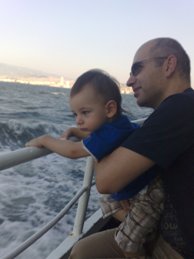Off topic: help translating middle eastern language Thread poster: fusupo
|
|---|
i have no real knowledge of what language, I've been told it's not arabic but something very old. It is found on a medallion worn around the neck. The text on both sides like a coin. Any input would be greatly appreciated as I have no starting point.
the link:
rg003.rabidgambit.net/scan001.jpg
my e-mail:
[email protected]
| | | | Selcuk Akyuz 
Türkiye
Local time: 02:18
English to Turkish
+ ...
| it may be Ottoman Turkish | Sep 20, 2004 |
written in Arabic script.
| | | | Randa Farhat 
Lebanon
Local time: 02:18
English to Arabic
+ ...
looks like some old Hebrew script or an ancient semitic!
| | | | | interesting... | Sep 21, 2004 |
there seems to be little concensus(on this forum or otherwise) as to what language this might be, someone(probably the guy at the local bodega) told me that it may be Urdu, which after a bit of 'net research seems plausible. It has also been suggested that this may be a very old system, one that may not be in use today. I'm wondering, the lay-man that I am, what are the difficulties in pin-pointing the origin of the text and what are some avenues I could persue to narrow the list of posibiliti... See more there seems to be little concensus(on this forum or otherwise) as to what language this might be, someone(probably the guy at the local bodega) told me that it may be Urdu, which after a bit of 'net research seems plausible. It has also been suggested that this may be a very old system, one that may not be in use today. I'm wondering, the lay-man that I am, what are the difficulties in pin-pointing the origin of the text and what are some avenues I could persue to narrow the list of posibilities(e.g. ask someone at a museum, library, university, and/or embassy). thanks again. ▲ Collapse
| | |
|
|
|
Adam Bartley 
Australia
Local time: 09:18
Member (2011)
Latin to English
+ ...
| World is oyster | Sep 21, 2004 |
As you have the image of the text, you have alot of options at your disposal. As the concensus is that it is a) Near-Easern or Central Asian and b) of a system no longer in use, you need, I think, to contact the curator of the appropriate collection in a suitable museum. The Pergamon Museum in Berlin has an excellent collection of material from the likely region/time-frame. I'd contact them by e-mail, including, maybe, the comments that you have from here. When you find out, drop back and let us... See more As you have the image of the text, you have alot of options at your disposal. As the concensus is that it is a) Near-Easern or Central Asian and b) of a system no longer in use, you need, I think, to contact the curator of the appropriate collection in a suitable museum. The Pergamon Museum in Berlin has an excellent collection of material from the likely region/time-frame. I'd contact them by e-mail, including, maybe, the comments that you have from here. When you find out, drop back and let us know! ▲ Collapse
| | | | LM
Local time: 01:18
English to Polish
+ ...
| No language at all | Sep 21, 2004 |
Of course the script is arabic (which is used for many languages, such as persian, pashto, urdu) but the text doesn't seem to make any sense - just the letters imitating some words. You may feel disappointed but such objects as your medallion are often sold to the tourists in the Near East. Many of those who manufacture them are illiterate and for thouse who buy them it doesn't make any difference. Of course I can be wrong so don't give up.
Good luck
Lucas
| | | | DGK T-I 
United Kingdom
Local time: 00:18
Georgian to English
+ ...
| Medallion inscription | Sep 21, 2004 |
fusupo wrote:
there seems to be little concensus(on this forum or otherwise) as to what language this might be, someone(probably the guy at the local bodega) told me that it may be Urdu, which after a bit of 'net research seems plausible. It has also been suggested that this may be a very old system, one that may not be in use today. I'm wondering, the lay-man that I am, what are the difficulties in pin-pointing the origin of the text and what are some avenues I could persue to narrow the list of posibilities(e.g. ask someone at a museum, library, university, and/or embassy). thanks again.
For Fusupo - it's an interesting puzzle. The reason why a mumber of different languages and scripts are being suggested as possibilities is because the lettering (appears) to look as if it's in an Arabic-related or Arabic-Persian related script - and Urdu, Persian (Farsi/W.Persian), Dari (E.Persian), Pashto, and Turkish (Ottoman period) are/were all widely used languages written in scripts related to Arabic. (Versions of scripts for these can be seen at http://www.omniglot.com/writing/urdu.htm and other entries in that site). Possibly the star and "five armed-snowflake" symbols are symbolic or ornamentation rather than letters.
I can see why Urdu was suggested - from Omniglot many of the letters seem to look particularly like Urdu letters, but I don't have the knowledge to be able to tell you if that's just a superficial impression (none of these are my languages). Diacritical marks (the dots) are generously sprinkled - I wonder what languages use so many dots (seemingly four dots in one mark).
- If you haven't already had an Urdu opinion, it's worth a try asking an Urdu-to-English kudos question (main menu - kudos - ask question), to see if any Urdu linguists answer who haven't seen this thread and give an opinion which helps, one way or the other.
It didn't seem to me to particularly resemble Aramaic, or Aramaic written in Syriac, or Hebrew (see also Omniglot), but that could just be my ignorance (the 'W' letter is like the letter 's~in' in Early Aramaic) - maybe there are cursive forms that look more like it, that I haven't seen. I was wondering about the writing of Arabic speaking Jews (looking for languages that might use 4 dot diacritical marks), but according to the internet they tended to write using mildly modified Hebrew letters with Arabic diacritical marks, so that didn't seem to help.
Selcuk Akyuz's suggestion is interesting - I was wondering (I knew Ottoman Turkish was written in an arabic script, but can't read it) - is that based on reading the characters and them producing a meaning seeming like something sensible in Turkish?
It's a good idea to approach a suitable museum with the image (why not send an e-mail to the museum suggested, with the image & what is known/speculated so far, and saying that it might be in an old script) - also you might be lucky contacting a university department that specializes in middle-eastern languages and/or artifacts.
One final question - is there any information about the medallion's provenance - what is known about where it was obtained, how old it is, etc? (if anything is known, include that in the e-mail).
(Sometimes) a problem is that different styles of script can be used for the same language and "alphabet", eg: at different times, confusing readers who aren't familiar with them.
On the other hand, perhaps Lucas is right and it's just nonsense (but it would be nice to find out definitely) (but it would be nice to find out definitely)
[Edited at 2004-09-21 12:14]
Later:
See also:
Urdu>English kudos question at http://www.proz.com/kudoz/816835
and a
Turkish>English kudos question at
http://www.proz.com/kudoz/816831
[Edited at 2004-09-22 06:26]
| | | | To report site rules violations or get help, contact a site moderator: You can also contact site staff by submitting a support request » help translating middle eastern language | Wordfast Pro | Translation Memory Software for Any Platform
Exclusive discount for ProZ.com users!
Save over 13% when purchasing Wordfast Pro through ProZ.com. Wordfast is the world's #1 provider of platform-independent Translation Memory software. Consistently ranked the most user-friendly and highest value
Buy now! » |
| | Protemos translation business management system | Create your account in minutes, and start working! 3-month trial for agencies, and free for freelancers!
The system lets you keep client/vendor database, with contacts and rates, manage projects and assign jobs to vendors, issue invoices, track payments, store and manage project files, generate business reports on turnover profit per client/manager etc.
More info » |
|
| | | | X Sign in to your ProZ.com account... | | | | | |







